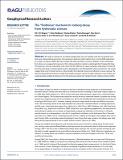Files in this item
The "footloose" mechanism : iceberg decay from hydrostatic stresses
Item metadata
| dc.contributor.author | Wagner, Till J. W. | |
| dc.contributor.author | Wadhams, P. | |
| dc.contributor.author | Bates, C. Richard | |
| dc.contributor.author | Elosegui, P. | |
| dc.contributor.author | Stern, A. | |
| dc.contributor.author | Vella, D. | |
| dc.contributor.author | Abrahamsen, E.P. | |
| dc.contributor.author | Crawford, A. | |
| dc.contributor.author | Nicholls, K.W. | |
| dc.date.accessioned | 2019-02-04T10:30:04Z | |
| dc.date.available | 2019-02-04T10:30:04Z | |
| dc.date.issued | 2014-08-16 | |
| dc.identifier | 146703665 | |
| dc.identifier | 986230e0-068e-423e-9afd-3d0132694ba4 | |
| dc.identifier | 84905327992 | |
| dc.identifier | 000341725200027 | |
| dc.identifier.citation | Wagner , T J W , Wadhams , P , Bates , C R , Elosegui , P , Stern , A , Vella , D , Abrahamsen , E P , Crawford , A & Nicholls , K W 2014 , ' The "footloose" mechanism : iceberg decay from hydrostatic stresses ' , Geophysical Research Letters , vol. 41 , no. 15 , pp. 5522-5529 . https://doi.org/10.1002/2014GL060832 | en |
| dc.identifier.issn | 0094-8276 | |
| dc.identifier.other | ORCID: /0000-0001-9147-7151/work/29591589 | |
| dc.identifier.uri | https://hdl.handle.net/10023/16995 | |
| dc.description | Authors are grateful to the Office of Naval Research High Latitude Program for supporting the University of Cambridge participation through the MIZ‐DRI project, grant N00014‐12‐1‐0130. T.J.W.W. further acknowledges ONR grant N00014‐13‐1‐0469. | en |
| dc.description.abstract | We study a mechanism of iceberg breakup that may act together with the recognized melt and wave-induced decay processes. Our proposal is based on observations from a recent field experiment on a large ice island in Baffin Bay, East Canada. We observed that successive collapses of the overburden from above an unsupported wavecut at the iceberg waterline created a submerged foot fringing the berg. The buoyancy stresses induced by such a foot may be sufficient to cause moderate-sized bergs to break off from the main berg. A mathematical model is developed to test the feasibility of this mechanism. The results suggest that once the foot reaches a critical length, the induced stresses are sufficient to cause calving. The theoretically predicted maximum stable foot length compares well to the data collected in situ. Further, the model provides analytical expressions for the previously observed "rampart-moat" iceberg surface profiles. | |
| dc.format.extent | 8 | |
| dc.format.extent | 1254725 | |
| dc.language.iso | eng | |
| dc.relation.ispartof | Geophysical Research Letters | en |
| dc.subject | Iceberg breakup observations | en |
| dc.subject | Iceberg beam theory | en |
| dc.subject | Iceberg modeling | en |
| dc.subject | GE Environmental Sciences | en |
| dc.subject.lcc | GE | en |
| dc.title | The "footloose" mechanism : iceberg decay from hydrostatic stresses | en |
| dc.type | Journal article | en |
| dc.contributor.institution | University of St Andrews. Centre for Ancient Environmental Studies | en |
| dc.contributor.institution | University of St Andrews. Marine Alliance for Science & Technology Scotland | en |
| dc.contributor.institution | University of St Andrews. Scottish Oceans Institute | en |
| dc.contributor.institution | University of St Andrews. St Andrews Sustainability Institute | en |
| dc.contributor.institution | University of St Andrews. School of Earth & Environmental Sciences | en |
| dc.contributor.institution | University of St Andrews. Earth and Environmental Sciences | en |
| dc.contributor.institution | University of St Andrews. School of Geography & Sustainable Development | en |
| dc.identifier.doi | https://doi.org/10.1002/2014GL060832 | |
| dc.description.status | Peer reviewed | en |
| dc.date.embargoedUntil | 2015-02-07 |
This item appears in the following Collection(s)
Items in the St Andrews Research Repository are protected by copyright, with all rights reserved, unless otherwise indicated.

